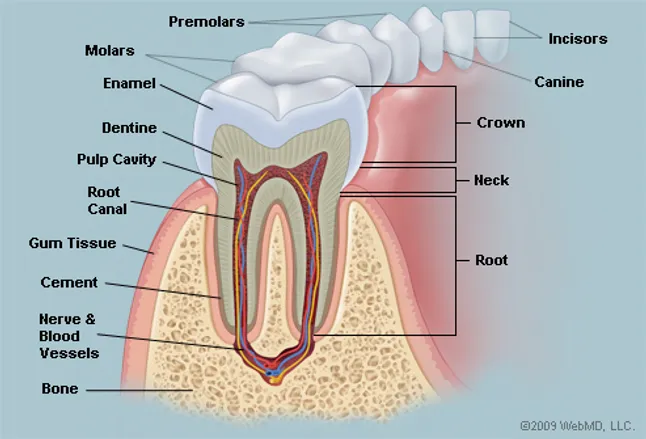Dental Care in an Emergency
21 Apr 2012
In the film “Cast Away,” Tom Hanks’ character is stranded on an island after his airplane crashes. On top of all the problems he has - learning to make a fire, finding food, water, shelter - he has a toothache!
This scared me half-to-death when I saw the film. I wondered, in an emergency, would I be able to take care of a simple toothache?
With the help of the Special Operations Forces Medical Handbook, we have highlighted some things that you can do to treat cavities, fractures, extracted teeth and more, in an emergency. These techniques should only be used in an emergency and are not a replacement for a qualified dental professional.
The handbook recommends that you have cotton balls, anesthetic, an explorer, a spoon excavator and a mixing tools. You will need some of these in order to take care of the problems we have listed below.
 Anatomy of a tooth
The first thing you’ll need to know about emergency dentistry is the anatomy of a tooth.
A tooth has two major parts - the crown and roots. The crown is the (hopefully) white part that is visible. The roots are embedded in your gums.
The crown has five surfaces: the occlusal (biting) surface, the lingual (tongue side) surface, the facial (cheek side) surface and two contact surfaces that touch the adjacent teeth.
Cavities
Symptoms. If you have a cavity, you’ll feel dull pain in the area. Heat, cold, sweet, or salty foods may enhance the pain. You’ll want to determine on which surface the cavity is located.
Treatment. Cavities can be very tricky to treat because of anesthesia.
The first thing you’ll do is apply an anesthetic agent. Be sure that you are trained on where the injection should be placed - which is near the top of the tooth’s root - in a mucobuccal fold. Do not inject into a blood vessel.
The Medical Handbook recommends the following anesthesia:
Anatomy of a tooth
The first thing you’ll need to know about emergency dentistry is the anatomy of a tooth.
A tooth has two major parts - the crown and roots. The crown is the (hopefully) white part that is visible. The roots are embedded in your gums.
The crown has five surfaces: the occlusal (biting) surface, the lingual (tongue side) surface, the facial (cheek side) surface and two contact surfaces that touch the adjacent teeth.
Cavities
Symptoms. If you have a cavity, you’ll feel dull pain in the area. Heat, cold, sweet, or salty foods may enhance the pain. You’ll want to determine on which surface the cavity is located.
Treatment. Cavities can be very tricky to treat because of anesthesia.
The first thing you’ll do is apply an anesthetic agent. Be sure that you are trained on where the injection should be placed - which is near the top of the tooth’s root - in a mucobuccal fold. Do not inject into a blood vessel.
The Medical Handbook recommends the following anesthesia:
 Anatomy of a tooth
The first thing you’ll need to know about emergency dentistry is the anatomy of a tooth.
A tooth has two major parts - the crown and roots. The crown is the (hopefully) white part that is visible. The roots are embedded in your gums.
The crown has five surfaces: the occlusal (biting) surface, the lingual (tongue side) surface, the facial (cheek side) surface and two contact surfaces that touch the adjacent teeth.
Cavities
Symptoms. If you have a cavity, you’ll feel dull pain in the area. Heat, cold, sweet, or salty foods may enhance the pain. You’ll want to determine on which surface the cavity is located.
Treatment. Cavities can be very tricky to treat because of anesthesia.
The first thing you’ll do is apply an anesthetic agent. Be sure that you are trained on where the injection should be placed - which is near the top of the tooth’s root - in a mucobuccal fold. Do not inject into a blood vessel.
The Medical Handbook recommends the following anesthesia:
Anatomy of a tooth
The first thing you’ll need to know about emergency dentistry is the anatomy of a tooth.
A tooth has two major parts - the crown and roots. The crown is the (hopefully) white part that is visible. The roots are embedded in your gums.
The crown has five surfaces: the occlusal (biting) surface, the lingual (tongue side) surface, the facial (cheek side) surface and two contact surfaces that touch the adjacent teeth.
Cavities
Symptoms. If you have a cavity, you’ll feel dull pain in the area. Heat, cold, sweet, or salty foods may enhance the pain. You’ll want to determine on which surface the cavity is located.
Treatment. Cavities can be very tricky to treat because of anesthesia.
The first thing you’ll do is apply an anesthetic agent. Be sure that you are trained on where the injection should be placed - which is near the top of the tooth’s root - in a mucobuccal fold. Do not inject into a blood vessel.
The Medical Handbook recommends the following anesthesia:
- 2% lidocaine with 1/100,000 epinephrine (Xylocaine)
- 0.5% bupivacaine with 1/200,000 epinephrine (Marcaine)
- 3% mepivacaine without epinephrine (Polocaine or Carbocaine)











